|
|
|
Sort Order |
|
|
|
Items / Page
|
|
|
|
|
|
|
| Srl | Item |
| 1 |
ID:
137219
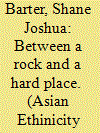

|
|
|
|
|
| Summary/Abstract |
Secessionist movements are often motivated by a sense of exclusion, abuse, and assimilation at the hands of host states. But in waging armed struggles and constructing ethnic nationalisms, they may replicate such grievances against their own minorities. This paper seeks to provide a deeper understanding of how ‘second-order minorities’ respond to secessionist ethno-nationalism. Based on ethnographic research in Aceh, Indonesia, this paper looks to how Javanese, Malay, Alas, and Gayo communities responded to Acehnese secessionism. Aceh’s minorities did not support Aceh’s rebels, opting to flee or resist rebellion. In explaining their reaction, I suggest that the same ethno-nationalist project which united many Acehnese in the secessionist struggle served to repel non-Acehnese communities, leading to ethno-nationalist revivals among Aceh’s minorities and continued tensions in the post-conflict era.
|
|
|
|
|
|
|
|
|
|
|
|
|
|
|
|
| 2 |
ID:
137224
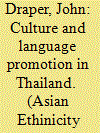

|
|
|
|
|
| Summary/Abstract |
This article examines the introduction of multilingual Thai/Thai Lao/English signage in commercial areas of the Faculty of Humanities and Social Sciences at Khon Kaen University, the principal tertiary university for the 19 million citizens of Northeast Thailand, the majority of whom are of the minority ‘Thai Lao’ ethnicity, an ideological construction that is presented in some detail. This introduction of signage followed a previous study to introduce officially sanctioned multilingual direction-giving signage, including the main faculty sign, in three prominent areas of the Faculty. The survey employed a complex methodology to survey the opinions of 300 students together with observation of students and interviews with members of the faculty. The research type is therefore a mixed-methodology investigation of identity and language policy planning, cultural promotion, glocalization, Gal and Irvine’s semiotic ideology structuration process, the (urban) linguistic landscape and Bourdieu’s theories of social reality. The study found high levels of support for the signage from the student body, members of the faculty and the stallholders themselves.
|
|
|
|
|
|
|
|
|
|
|
|
|
|
|
|
| 3 |
ID:
137218
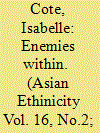

|
|
|
|
|
| Summary/Abstract |
How can we account for the targeted pattern of violence in Xinjiang, in which Uyghur secessionist groups attack some second-order minorities such as the Han Chinese and the Hui, but not the sizeable populations of Kazak, Kyrgyz, and Mongol minorities? Based on a variety of primary and secondary sources, I argue that members of the Han minority, being the national majority in China but a ‘nested minority’ in Xinjiang, are doomed to become a primary target of secessionist attacks as they represent, in and of themselves, the state from which Uyghur nationalists are trying to secede. Han Chinese’s – and to a lesser extent the Hui’s – economic and political dominance over the Uyghurs, along with their lack of historical ties to Xinjiang, also motivates their targeting while reinforcing the bond between other indigenous and comparatively disadvantaged minorities.
|
|
|
|
|
|
|
|
|
|
|
|
|
|
|
|
| 4 |
ID:
137221
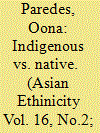

|
|
|
|
|
| Summary/Abstract |
Two categories of ethnic minority – Moro and Lumad – are indigenous to the Philippine island of Mindanao, with Muslim Moros outnumbering largely animist Lumads. Both have been profoundly displaced by the post-World War II influx of Christian Filipino settlers from other islands, leading to armed conflict with the national government over land and political control. Due to their political and demographic inferiority to Moros, Lumads have regularly resorted to the accommodation and assimilation of Moro priorities, including throwing their support behind the latters’ decades-long struggle for territorial autonomy. Thanks to wide public support among the Lumad and other Mindanao sectors, the latest peace talks between the government and Moro leaders has led to the signing of a major peace deal involving the creation of a new autonomous Bangsamoro homeland. Despite this, the legitimate needs of Lumad stakeholders have been ignored, and in some cases deliberately undermined, by Moros and the national government. This article analyses the post-conflict status of the Lumad who, as second-order minorities in the future Bangsamoro homeland, have been doubly marginalized in daily life and in the peace process. It concludes that denying Lumad concerns now will render Bangsamoro more vulnerable to legal and constitutional challenges, as well as jeopardize the unique ‘tri-people’ ethos that has made this the most firmly grounded peace process to date.
|
|
|
|
|
|
|
|
|
|
|
|
|
|
|
|
| 5 |
ID:
137222
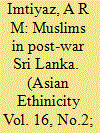

|
|
|
|
|
| Summary/Abstract |
This study attempts to understand the recent mobilization against the Sri Lankan Muslim community by Sinhala-Buddhist organizations. In doing so, it adds to the discussion about the relationship between second-order minorities and the state and how identities can be manipulated pre- and post-conflict. States, led by majority ethnic groups, may choose to work with second-order minorities out of convenience in times of crisis and then dispose of them afterwards. The article will attempt to look critically at some state concessions to Muslim political leaders who supported successive Sri Lanka’s ruling classes from the independence through the defeat of the Tamil Tigers in 2009. It will also examine the root causes of the Sinhala-Buddhist anti-Muslim campaigns. Finally, it will discuss grassroots perspectives by analysing the questionnaire on the anti-Islam/Muslim campaign that was distributed to youth, students, unemployed Muslims and workers in the North-Western and Western provinces.
|
|
|
|
|
|
|
|
|
|
|
|
|
|
|
|
| 6 |
ID:
137217
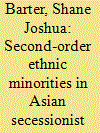

|
|
|
|
|
| Summary/Abstract |
This article provides some conceptual foundations for a special issue of Asian Ethnicity concerned with what we call ‘second-order minorities’. If secessionist conflicts involve minorities resisting abusive, assimilationist states, leading rebel groups to embark on their own nation-building efforts, how does this affect the minorities of aspiring secessionist nations? How do the minorities of secessionist groups respond to secessionism? Despite many insightful studies of secessionism and rebel ethno-nationalism, scholars have yet to explore the ways that local minorities navigate secessionist conflicts. We suggest that the relationship between secessionists and second-order minorities depends on three key factors: whether minorities are territorially concentrated or dispersed, indigenous or migrant, and nation majorities or small national minorities. These characteristics provide us some idea of the types of violence and counter-mobilization we might see among second-order minorities faced with secessionist violence. This article then previews the subsequent studies of Xinjiang, Aceh, Mindanao, and Sri Lanka, cases which capture some of the core challenges faced by second-order minorities against twin violent nation-building efforts from state and rebel forces.
|
|
|
|
|
|
|
|
|
|
|
|
|
|
|
|
| 7 |
ID:
137225
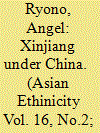

|
|
|
|
|
| Summary/Abstract |
In 2009, a demonstration in Urumqi deteriorated into one of the bloodiest riots in contemporary Chinese history. Some scholars and media groups have responded to the event by focusing public attention on the bottom-up, ethnic, and social aspects of Xinjiang’s conflict phenomenon. This article raises questions and concerns about framing the 2009 event from an ethnic and social standpoint. The authors combine conflict studies with a longue durée historical analysis to argue that multiple dimensions and the intersections of these dimensions constitute the 2009 Urumqi uprising. Present conflict is placed against a backdrop of unequal Chinese state policies with Xinjiang. The authors then forward a Uyghur perspective underpinned by peace and conflict studies concepts. The conclusion recommends conflict prevention strategies by urging the Government of the People’s Republic of China to take ownership of the consequences of its policies and the broken contracts with Uyghur minorities in Xinjiang.
|
|
|
|
|
|
|
|
|
|
|
|
|
|
|
|
|
|
|
|
|